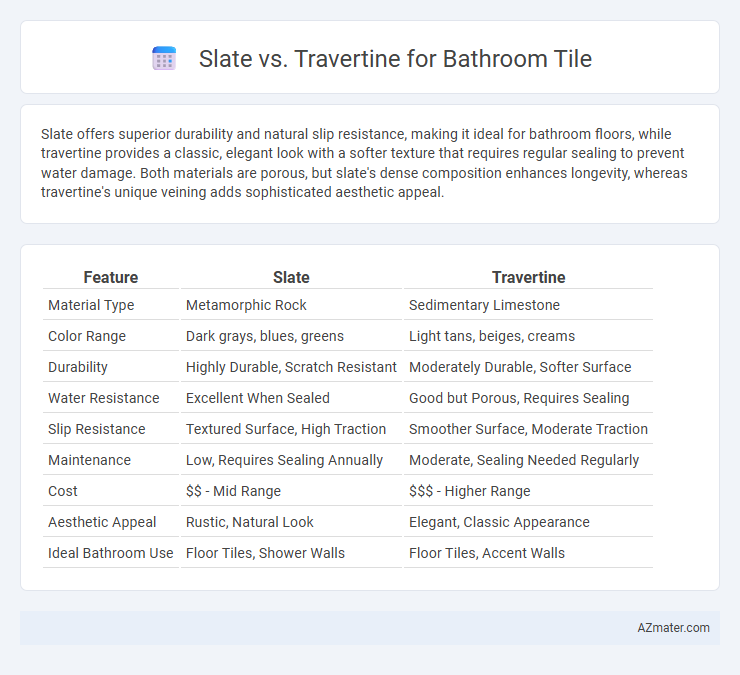Slate offers superior durability and natural slip resistance, making it ideal for bathroom floors, while travertine provides a classic, elegant look with a softer texture that requires regular sealing to prevent water damage. Both materials are porous, but slate's dense composition enhances longevity, whereas travertine's unique veining adds sophisticated aesthetic appeal.
Table of Comparison
| Feature | Slate | Travertine |
|---|---|---|
| Material Type | Metamorphic Rock | Sedimentary Limestone |
| Color Range | Dark grays, blues, greens | Light tans, beiges, creams |
| Durability | Highly Durable, Scratch Resistant | Moderately Durable, Softer Surface |
| Water Resistance | Excellent When Sealed | Good but Porous, Requires Sealing |
| Slip Resistance | Textured Surface, High Traction | Smoother Surface, Moderate Traction |
| Maintenance | Low, Requires Sealing Annually | Moderate, Sealing Needed Regularly |
| Cost | $$ - Mid Range | $$$ - Higher Range |
| Aesthetic Appeal | Rustic, Natural Look | Elegant, Classic Appearance |
| Ideal Bathroom Use | Floor Tiles, Shower Walls | Floor Tiles, Accent Walls |
Overview: Slate vs Travertine Bathroom Tiles
Slate bathroom tiles offer a natural, textured surface with excellent durability and water resistance, making them ideal for wet environments. Travertine tiles provide a smooth, porous finish with warm earth tones, requiring sealing to prevent moisture damage in bathrooms. Choosing between slate and travertine depends on desired aesthetics, maintenance level, and slip resistance for bathroom tile applications.
Aesthetic Differences Between Slate and Travertine
Slate offers a natural, rustic appearance with rich, dark tones and textured surfaces, creating a bold and dramatic look in bathroom spaces. Travertine features a warm, earthy palette with soft, porous textures and subtle veining, lending a classic, elegant, and Mediterranean-inspired ambiance. The distinct color variations and surface finishes of slate and travertine significantly influence the overall bathroom aesthetic, with slate providing a more rugged, contemporary feel and travertine delivering timeless sophistication.
Durability and Strength Comparison
Slate offers superior durability and exceptional strength, making it highly resistant to cracks and chips in high-moisture bathroom environments. Travertine, while visually appealing with its natural porous texture, requires more frequent sealing to maintain its structural integrity and prevent water damage. Slate's dense composition ensures long-lasting performance and minimizes maintenance compared to the softer, more absorbent travertine.
Water and Stain Resistance
Slate offers superior water resistance compared to travertine due to its dense, non-porous surface, making it ideal for high-moisture bathroom environments. Travertine, while elegant, is more porous and requires regular sealing to prevent water absorption and staining from common bathroom products. Proper maintenance enhances the longevity of both materials, but slate's natural resistance to water and stains provides a more durable option for bathroom tile applications.
Slip Resistance and Safety
Slate offers superior slip resistance for bathroom tiles due to its naturally textured surface, making it a safer choice in wet conditions compared to travertine. Travertine, while aesthetically pleasing with its smooth, porous surface, tends to be more slippery when wet, increasing the risk of falls. Choosing slate tile enhances bathroom safety by reducing slip hazards, especially in high-moisture areas.
Maintenance and Cleaning Requirements
Slate bathroom tiles require regular sealing to prevent moisture absorption and staining, with cleaning involving mild detergents and avoiding acidic or abrasive cleaners to maintain their natural texture. Travertine tiles also need periodic sealing to protect their porous surface but demand gentle cleaning with pH-neutral cleaners to avoid etching and damage. Both materials benefit from prompt spill cleanup and soft brushes or cloths for maintenance, ensuring long-lasting durability and aesthetic appeal in bathroom environments.
Installation Process Differences
Slate bathroom tile installation requires careful handling due to its natural cleft surface, often necessitating a leveling underlayment to ensure a flat substrate, while travertine tiles, with their smoother surface, typically demand less preparation but benefit from sealing to prevent water absorption. Slate tiles are heavier and may require stronger adhesive mixtures and additional curing time, whereas travertine's uniform thickness allows for faster setting using standard thin-set mortar. Proper grout selection varies, with urethane grout preferred for slate to handle its uneven texture, and cement-based grout commonly used for travertine to complement its porous but smoother finish.
Cost and Value Analysis
Slate bathroom tiles generally cost between $7 to $15 per square foot, offering durability and natural slip resistance that enhance long-term value despite higher initial investment. Travertine tiles range from $3 to $10 per square foot, providing a classic, elegant look but requiring more maintenance and sealing, which may increase lifetime expenses. When evaluating cost and value, slate is often preferred for longevity and low upkeep, whereas travertine suits budget-conscious projects prioritizing aesthetic appeal.
Eco-Friendliness and Sustainability
Slate bathroom tiles offer superior eco-friendliness due to their natural formation and long-lasting durability, reducing the need for frequent replacements and minimizing waste. Travertine, while also a natural stone, often undergoes more intensive quarrying and processing, which can increase its environmental footprint compared to slate. Choosing slate supports sustainable bathroom design by utilizing a material that requires less energy for extraction and maintenance, contributing to greener building practices.
Best Applications and Design Ideas
Slate offers superior durability and natural slip resistance, making it ideal for bathroom floors and wet areas, while travertine's porous texture requires sealing but provides a warm, elegant look perfect for walls and vanity backsplashes. Slate's dark, earthy tones complement rustic and modern farmhouse designs, whereas travertine's soft beige and cream hues suit Mediterranean and classic styles. Combining slate flooring with travertine accents creates a sophisticated contrast that enhances both texture and color in bathroom interiors.

Infographic: Slate vs Travertine for Bathroom Tile
 azmater.com
azmater.com